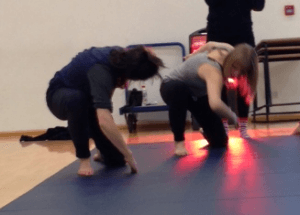Tuesday 4th February 2014
Steven Paxton describes contact improvisation as an investigation of weight, touch, and communication. For me contact improvisation is a practice based primarily around trust, weight and touch experimentation, being able to let your body explore what it wants to. Integrating what we did in our previous classes with the element of touch today, defined by Montagu as ‘…the parent of our eyes, ears, nose and mouth. It is the sense, which became differentiated into the others, a fact that seems to be recognized in the age-old evaluation of touch as ‘the mother of the senses’.’ (Bannon and Holt, 2012, 218) showed us the significance and effectiveness of the element touch.
“To understand…” means to me that I need to realise where my body is at the beginning of every class. We always start of class with a “small dance” a moment of stillness honing in on gravity and the tiny movements that your body makes when standing still. Today I felt completely focused after this exercise and I brought my body into the room with me unlike previous classes where it was a longer process. I think the reason for me feeling the benefits of the small dance today is due to previous experimentations. You really need to explore something to understand its benefits and purpose, I now understand that the “small dance” helps you to get into your body and start to feel any small or large movement it creates which I will now be engaging in at the beginning of every class.
Further into the class we looked into Paxton’s puzzles are small phrases of movements with a specific technqiue to help with control and sustaining movement. We developed the Crescent and Helix roll using; the eyes as a connection for direction of the movement and thinking long and low with the direction of our legs. We further explored the Aikido roll which we were introduced to briefly last week. The challenging aspect of this roll is the weight suspension at the beginning of the roll and I found that I need to focus on keeping strong positions in the arms and legs.
An improvisational score was the last hour of our class and it was an exciting and new place for all of us. This space allowed us as a group to combine elements we have learnt over the past week and explore them as a whole class together, opening up the question for ourselves, what is contact improvisation? For me it’s still being answered.
‘What is your pallet today?’ (Silverthorn, 2014) is an extraordinary question that my tutor asks on occasions in classes originating from Steve Paxton. He describes this question as imagining that your body is a pallet of sensations in comparison to an artist having a pallet of paint. Use the sensations and embrace them in your movement.
Works cited:
Silverthorn, T. (2014) Paxton’s Material for the Spine and formative assessment of learning outcomes one and two [seminar] Contact Improvisation: An Ongoing Research Lab DAN2005M, University of Lincoln, 4 February.
Bannon, F. and Holt, D. (2012) Touch: Experience and knowledge. Journal of dance and somatic practices, 3(1/2) 215-227.
